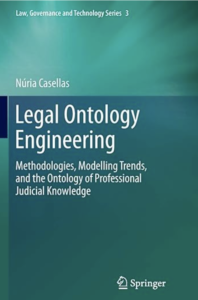Application of ontology to the legal field
An ontology is a formal definition of concepts and relationships in a particular domain, which is useful for sharing knowledge and integrating information in that domain. The application of ontologies in the legal field is expected to facilitate the organization and sharing of information on legal matters and contribute to the automation and efficiency of legal processes It is expected to contribute to the automation and efficiency of legal processes.
This can be achieved, for example, by creating an ontology on a legal domain, which formally defines concepts such as legal terms, relationships, and legal procedures, facilitating automated analysis of legal documents and retrieval of related legal information for efficient use in solving legal problems, or by using an ontology to The sharing of legal information using ontologies facilitates the sharing of information across different jurisdictions, languages, and cultures, and facilitates the exchange of information and knowledge in areas such as international law and business transactions.
Challenges when applying ontology technology to the legal field include differences in legal terminology and concepts, differences in cultural backgrounds, and differences in legal systems. In addition, appropriate advice and expert assistance are needed when people who do not have knowledge and experience as legal experts are involved in the design and operation of ontologies.
The application of ontology technology to the legal field is described here based on “Legal Ontology Engineering: Methodologies, Modelling Trends, and the Ontology of Professional Judicial Knowledge.

This book describes the methods, tools, and languages used to develop ontologies for creating semantically enhanced legal knowledge systems and semantic web-based applications that aim to enable information interoperability, improve the retrieval of legal information, and increase the reusability of legal knowledge by applying ontology and semantic technologies. The paper describes the methods, tools and languages used to develop ontologies for creating semantically enhanced legal knowledge systems and web-based applications with the aim of improving the reusability of legal knowledge. As a case study, the development of the Ontology of Professional Judicial Knowledge (OPJK) is introduced.
Legal-ontology is a specific system that has been developed in the context of eGovernment to improve the interoperability of legal procedures and documents in Europe. Various approaches have been implemented, ranging from the integration of different language information to the modeling of judicial processes with the differences in national practices in mind. Specific examples include LLD (Language for Legal Discourse), LEGOL (Legal Oriented Language), NORMA, CABALA, FBO (Frame-Based Ontology), FOLaw (Functional Ontology of Law), CLIME FBO (Frame-Based Ontology), FOLaw (Functional Ontology of Law), CLIME Ontology, Mommer’s Knowledge-baed Model of Law, LRI-core, etc.
The table of contents is as follows.
Chapter1 Introduction
1.1 Legal Knowledge Management
1.2 Semantic Web Technologies and Application
1.2.1 Legal Ontologies for Legal Knowledge Representations
1.2.2 Legal Experts for Legal Ontology Development
Chapter2 On Ontologies
2.1 Introduction
2.2 Understanding Ontology
2.2.1 What Is an Ontology?
2.3 Types of Ontologies and Design Criteria
2.3.1 Typology of Ontology
2.3.2 Other Design Criteria
2.3.3 On Legal Ontologies
2.4 Some Conclusion : A Set of Types
Chapter 3 Methodologies, Tools and Languages for Ontology Design
3.1 Introduction
3.2 Methodologies and Methods for Ontology Design
3.2.1 Current Ontology Methodologies
3.3 Languages and Tools for Ontology Modeling
3.3.1 Representation Languages
3.3.2 Ontology Modeling Tools and Environment
3.4 Conclusions and Some Thoughts on Expert Participation in Ontology Development
Chapter 4 Legal Ontologies
4.1 A Review
4.2 Existing Legal Ontologies
4.2.1 Early Conceptualization of the Legal Domain
4.2.2 Legal Ontologies
4.2.3 More Legal Ontologies
4.3 Some Conclusion of the Analysis
Chapter 5 Modeling Judicial Professional Knowledge: A Case Study
5.1 The Ontology of Professional Judicial Knowledge
5.2 Requirements and Knowledge Acquisition
5.2.1 Initial Research and Ethnography
5.2.2 Specification of Requirements
5.2.3 Knowledge Acquisition
5.2.4 Acquisition of Conceptual Domain Knowledge
5.3 Conceptualization and Formalization
5.3.1 Classes、rdfs:subClassOf Relations, and Instances
5.3.2 owl:ObjectProperty and Further Constructs
5.3.3 Some Last Comments
5.4 Evaluation and Refinement
5.4.1 Purpose-Focused Evaluation
5.4.2 Ontology-Focused Evaluation
5.4.3 Refinement
5.4.4 Discussion:A Socio-Legal Approach
Chapter 6 Some Final Remarks and Issues for Discussion
6.1 Comments on the State-of-the-Art
6.2 The Socio-Legal Expert-Based Approach to Ontology Development
6.3 Issues for Discussion
Application of AI Technology to the Legal Field
AI technology is widely used in the legal field. The following are examples of applications of AI technology in the legal field.
- Legal research and document analysis: AI technology can be used to automatically analyze large volumes of legal documents and precedents, and combined with natural language processing and machine learning techniques, it can extract key points and important information from contracts and legal documents to support efficient legal research.
- Legal Forecasting and Risk Assessment: AI technology can be used to analyze precedents and historical legal data to predict rulings and assess risk in specific cases. This can assist in legal decision-making and dispute resolution and help minimize legal risk.
- Automated Contract Creation and Contract Management: AI technology can be used to automate contract creation and contract management processes. This allows AI systems to extract contract clauses, create templates, and monitor for contract violations, resulting in more efficient contract operations and early detection of contract violations.
- Legal assistants and chatbots: Legal assistants and legal chatbots can be developed by applying natural language processing and dialogue system technologies. They can provide efficient information and support to clients and legal departments by providing legal advice and procedural guidance in response to their questions.
- Case Summarization and Trial Prediction: AI technologies can be used to summarize precedents, extract key points and summaries of decisions, and analyze precedents and build predictive models to predict trial outcomes in specific cases and assess case win rates.
The application of these AI technologies will benefit the legal field by increasing efficiency, improving accuracy, and reducing costs, while also contributing to improved legal decision-making and client service. However, legal professionalism and ethical considerations require caution in the application of AI technologies, and the importance of the judgment and expertise of legal professionals still exists.


コメント